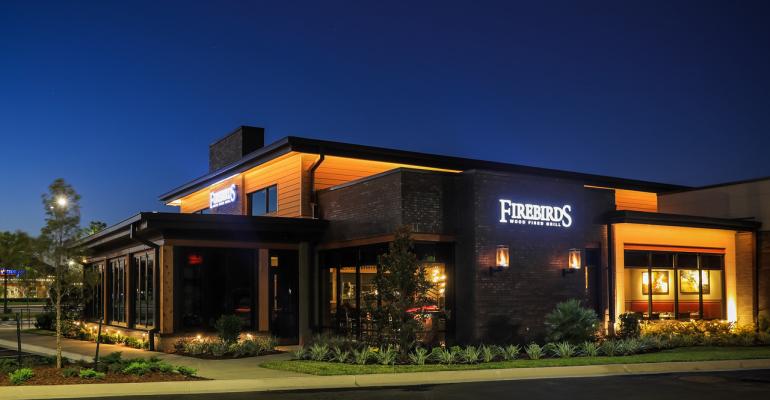In 2019, Firebirds Wood Fired Grill spent a lot of time building a robust digital infrastructure to support its growing to-go business — not possibly knowing the channel would become a necessity a year later. That decision is still paying off, according to CEO Steve Kislow.
“Sometimes it’s better to be lucky than good,” he joked during a recent interview at the ICR Conference in Orlando. “While others in the polished casual space were scrambling to try and figure out an off-premises model, we had already done it. When we came out on the other side, we didn’t lose as much as many did. Then it was a rocket ship.”
It still is. Firebirds experienced over 19% sales growth last year, according to Technomic Ignite data, and throughout the past five years has outpaced the broader upscale casual segment by nearly 8%. Kislow said less than half of that 19% sales growth came from pricing, which means the concept likely gained market share within its segment.
“We were a little slower to take price. We didn’t really take it until later in 2021, so I’d say less than 50% of it is price and the rest is a combination of traffic inside the restaurant and the off-premises mix that continued to grow for us,” he said.
The to-go business has stabilized between 15% and 17%, whereas before the pandemic, it was about 4%. It is no doubt a wildly different business than it was in 2019, with overall volumes up 45% versus that time. Further, AUVs are now above $5.3 million, versus $4.6 million in 2021. Kislow, who served as a general manager, then director of operations, then COO, was prepared to lead the company through such a significant operational transformation by balancing the needs of off-prem and dine-in guests.
“Since we had an (off-premises) infrastructure in place, it allowed us to start messaging that program early and make it better — using tech like Flybuy so our staff knew when it was time to meet customers outside, things like that. We wanted our customers to notice certain things like our to-go boxes, which feel like more off a Tupperware-type box,” Kislow said. “We are making the off-premises experience experiential versus just having something, and it has allowed us to gain market share.”
At the same time, Firebirds has been gaining dine-in market share by also focusing on operational efficiencies. Kislow said, for example, the company “throttles” digital orders during peak times so the influx doesn’t compromise dine-in guests’ experience. Such throttling doesn’t mean turning off to-go or delivery orders, but rather taking less orders during those times.
“We don’t want to impact the core competency of the brand,” he said. “The reality is Firebirds is an experiential brand and our pricing is a little more than just casual dining, so there has to be value there.”
With this rhythm down pat and with the backing of Garnett Station Partners, which acquired Firebirds in March 2023, the company is now focused on ramping up its growth. It will open its 60th location at the end of February, with seven additional leases signed so far this year and six to eight planned for next year for a growth clip above 10%. Kislow said there is a lot of opportunity to infill markets where the concept already exists, which is where the focus will be for the near term.
“We’ll do a couple of new markets, but there's not a reason for us to blaze new trails and take on any additional risk when we have as many great opportunities as we have in markets that we already have brand awareness, distribution, efficiencies, multi-unit leadership,” Kislow said. “We can continue to leverage some of the things we have.”
In fact, Kislow attributes the chain’s growing AUVs to opening in markets where there is existing brand awareness, along with a disciplined real estate strategy.
“It’s all about great real estate … We want people to see our buildings and our personality,” he said.
Kislow is especially bullish about the concept now as predictions of a softening consumer start to grow. He believes Firebirds is well positioned in such an environment because “there is no veto vote on our menu.”
“When you sit smack in the middle of casual and fine dining, where folks are softening up from fine dining, they don’t want to go all the way down to the other side of the pendulum,” he said.
He is also bullish because of the initiatives the company has in place this year, such as adding topping to steaks, training servers to time orders better to get in a second cocktail, stronger messaging around its salad program, and so forth. All of these initiatives will be better executed by making sure the right people are in place, just as they have been since the beginning.
“Our leadership team is as excited about opening number 60 as we were when we opened number six,” he said. “The important thing for us is to make sure our employees have an environment where they feel safe and energized and they make the guests feel the same way. The important thing as we grow is not losing that.”
Contact Alicia Kelso at [email protected]





